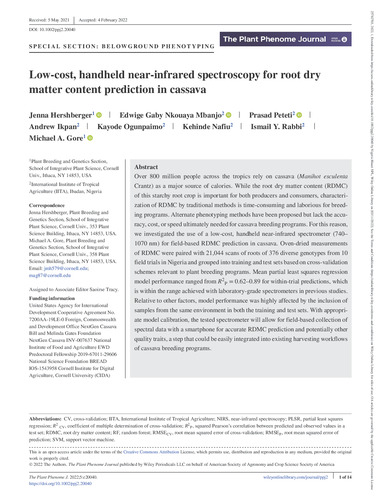Low-cost, handheld near-infrared spectroscopy for root dry matter content prediction in cassava
Abstract
Over 800 million people across the tropics rely on cassava (Manihot esculenta Crantz) as a major source of calories. While the root dry matter content (RDMC) of this starchy root crop is important for both producers and consumers, characterization of RDMC by traditional methods is time-consuming and laborious for breeding programs. Alternate phenotyping methods have been proposed but lack the accuracy, cost, or speed ultimately needed for cassava breeding programs. For this reason, we investigated the use of a low-cost, handheld near-infrared spectrometer (740–1070 nm) for field-based RDMC prediction in cassava. Oven-dried measurements of RDMC were paired with 21,044 scans of roots of 376 diverse genotypes from 10 field trials in Nigeria and grouped into training and test sets based on cross-validation schemes relevant to plant breeding programs. Mean partial least squares regression model performance ranged from R2P = 0.62–0.89 for within-trial predictions, which is within the range achieved with laboratory-grade spectrometers in previous studies. Relative to other factors, model performance was highly affected by the inclusion of samples from the same environment in both the training and test sets. With appropriate model calibration, the tested spectrometer will allow for field-based collection of spectral data with a smartphone for accurate RDMC prediction and potentially other quality traits, a step that could be easily integrated into existing harvesting workflows of cassava breeding programs.

